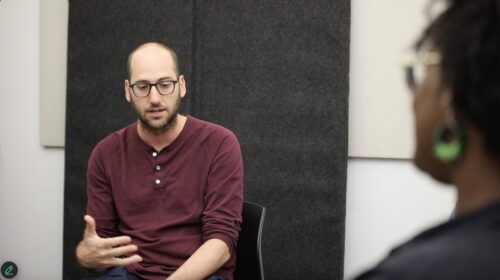A practitioner shares his experience with Healing Connections, a restorative accountability group for people who have caused harm in their relationships.
By Alex Genty-Waksberg, Program Manager of Healing Connections
Growing up, I had three best friends. I could tell these guys anything and knew I wouldn’t be judged. As we got older, we compared notes on our sexualities, our families, our crushes, our anger. They helped me understand myself more deeply and they kept me in check.
Today, in my work as a restorative justice facilitator and program manager of Healing Connections, I often think of these friends and how fortunate I was to have soft, supportive boys that I could talk with openly.
Healing Connections is a restorative-practice based accountability group, focused on our intimate relationships and how to make them healthier, safer, and more loving. Participants in the group often have a court mandate to complete a Domestic Violence Accountability Program, but we also accept voluntary participants.
We start by creating community guidelines for how to be together, and identify the values that are important to us and that will support our endeavor to be in a good relationship. Each week, we sit in a circle, sharing one by one. We practice checking in with ourselves and our needs, tell stories about how we were raised, and interrogate what we were taught about gender—guided by authenticity, intentionality, and active listening. Sharing about ourselves openly in community expands our capability for compassion and our willingness to make repair.
We all have wisdom to share, and my role as facilitator is to create a safe enough space for those stories, reflections, and teachings to be shared.
It is important that we don’t create a rigid separation between facilitators and participants. So one of the first things I tell participants is that this is not a classroom and I am not their teacher. We are all trying to work on ourselves and our relationships, and I, like them, have my own work to do.
In relationships where I felt insecure, I expressed that insecurity as anger or jealousy and acted in a controlling way. When I felt my own sadness creeping in, I would pick a fight so that I could feel like I was transferring that sadness to someone else. I am motivated to have these conversations in Healing Connections because I’ve seen in myself the same tendencies that lead to abusive and controlling behavior. I model taking responsibility for the harm I’ve inflicted on intimate partners without the stigma and shame that often gets in the way of that.
We all have wisdom to share, and my role as facilitator is to create a safe enough space for those stories, reflections, and teachings to be shared. Collectively, we break down our knee-jerk defenses around being labeled a ‘wife-beater’ or an ‘abuser’ and encourage participants to think critically about their role in causing verbal, physical, or psychological harm. Moving past the stage of denial, we can reflect on our responsibility and agency in our relationships.
Our technological advancements have not transcended the power of collective healing.
Participants of Healing Connections, most of whom come from Black and Brown communities, are often overenrolled in programs and demoralized. The legal system may have instituted a protective order against them, with or without the consent of the protected person. Sometimes it has imposed limited and/or supervised visits with their children. They are often underemployed due to structural inequities and the collateral consequences of criminal convictions. We can’t ignore the institutional harm inflicted against these participants that often preceded the interpersonal harm they committed. By making space to talk about the harm we have experienced, we create room for understanding and healing and build the trust needed to begin difficult conversations about our own accountability.
Over the sixteen weeks of our groups, participants name moments of transformation. One recognized that holding in his thoughts and a lack of communication had led to harm in the past. In Healing Connections, he learned to be more expressive and to de-escalate heated situations. A woman, after participating in the group, felt better equipped to communicate with her son as he gets older. Another participant committed to learning their triggers and trauma, so that they could help their children deal with theirs. Participants who came in saying that they had nothing to learn, and dreaded that very first session, left the group committed to being better partners and parents.
Domestic violence and relationship harm is an epidemic that touches everyone. Though I do this work professionally, I am by no means a perfect partner (or a perfect son, brother, uncle, or friend). But I am more aware of how I feel and how to communicate those feelings. I have a stronger sense of the damaging effect that my behavior can have on the people around me and on myself.
As we wring our hands about the state of masculinity in the nation, or about how isolating our AI-dominated future might be, groups like Healing Connections are all the more essential. I’ve been encouraged by the sheer range of talented, compassionate people who are engaged in doing this work effectively, safely, and ethically; both in the community and in mandated services. Our technological advancements have not transcended the power of collective healing.
We all deserve to have people in our lives who make us feel safe enough to be vulnerable, just like I had growing up.
We’re proud to work alongside countless organizations dedicated to building a world free from intimate partner and domestic violence. You can find out more about some of these organizations here: the Center’s RISE and Gender and Family Justice team, Ahimsa, the Family Peace Initiative in Kansas, Rising Ground, Urban Resource Institute, VIP, Anti-Violence Project.
